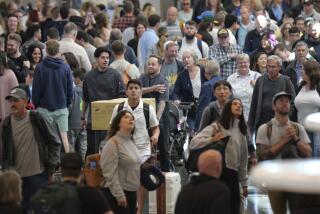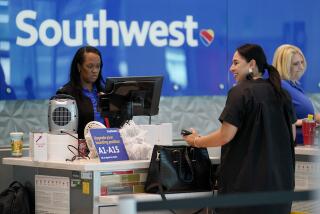Fares Higher, Fuel Costs Stable : Airlines’ Revenue Up Even as Traffic Slows
- Share via
NEW YORK — The growth in passenger traffic at U.S. airlines is slowing, but a combination of higher fares and moderating expenses should provide good second- and third-quarter earnings, analysts say.
“The (April) passenger numbers don’t look that good,” said Jeffrey Perry of C. J. Lawrence Morgan Grenfell. “But business is still fairly strong” when you factor in air fares, he said.
April traffic at major carriers was about even with April, 1987, but sharply higher average fares should produce revenue increases of 12% to 13% in the month, analysts said. Traffic figures are measured in revenue passenger miles. A revenue passenger mile is one paying passenger flown one mile.
“Traffic growth is clearly slowing,” one analyst said. “But the other side of the equation is that we’re seeing a significant improvement in yields (average fares), so we’ll see some pretty decent comparisons in the second quarter.”
Airlines typically make most of their money in the second and third quarters, when air travel is the heaviest. This year, summer traffic will probably be flat to up 4% or 5%, compared to large increases of 10% to 15% last year.
But yields should rise 7% to 10%, the analysts said, providing substantial revenue gains.
Fares started rising last summer after airlines cut prices early in 1987 to stimulate traffic. But the increases were gradual and have picked up steam in 1988.
For example, in March the airlines eliminated unrestricted discount fares that had been widely used by business travelers. As a result, analysts said, business travelers are paying far more to travel.
Fuel Prices Flat
The carriers also raised other fares. Discount fares are still available but carry heavy restrictions.
“The revenue environment is very positive,” said Jim Vail of Eberstadt Fleming.
Costs will continue to rise but at a slower rate, other analysts said. Compared to last year, fuel prices will be flat or up slightly in the second quarter. But given stable oil prices, they will probably fall in the second half, they said.
“The industry has three things going for it--traffic, yields and oil prices. They’re all going in the right direction,” said Michael Derchin of Drexel Burnham Lambert.
He said the summer should be “gang busters,” based on traffic growth of 4% to 5% and yields improving 7% or 8%.
Edward Starkman of Paine Webber said a strong summer would build on the first quarter, when the industry posted operating profits of about $140 million, up from $85 million in the 1987 quarter. “It’s looking like a very good year,” he said.
Early Easter
Traffic at major carriers will likely show some growth in May, but total summer travel could be flat or up only a bit. “But traffic is only part of the picture. You’ve got to look at what the traffic is putting in your pocket,” he said.
May and June traffic could be more indicative of summer travel trends than April because special factors affected last month’s results, Starkman and others said.
Easter was early this year, pulling some traffic from April back into March, analysts said. First-quarter traffic rose about 5%.
In addition, the airlines were up against a good April last year. Domestic traffic rose about 17% in April, 1987, while average fares fell because of heavily discounted Maxsaver fares, said Drexel Burnham’s Derchin. “It was the first time Maxsavers were available (early in 1987) and then fares went up substantially in May. So there was a one-time big increase in April traffic last year,” he said.
Analysts cautioned that some carriers, notably Eastern Airlines, a Texas Air Corp. unit, and Pan Am Corp.’s Pan American World Airways would likely post weak summer results relative to the industry.
“The ones with the labor strife will have the biggest problems over the summer,” said one analyst.
Eastern and Pan Am have been locked in battles for concessions from their unions.
More to Read
Sign up for The Wild
We’ll help you find the best places to hike, bike and run, as well as the perfect silent spots for meditation and yoga.
You may occasionally receive promotional content from the Los Angeles Times.






